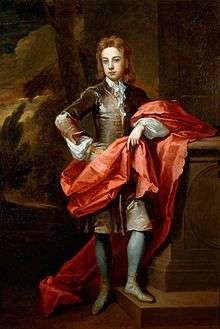James Vernon the Younger
James Vernon the Younger (15 June 1677 – 17 April 1756) was a British government official, courtier, diplomat and Whig politician who sat in the House of Commons from 1708 to 1710. He was an envoy to Denmark from 1702 to 1707.

Early life
Vernon was the eldest son of James Vernon and his wife Mary Buck, daughter of Sir John Buck, 1st Baronet, of Hamby Grange, Lincolnshire. His father was Secretary of State under William III. He was educated at Utrecht in 1690, at Rotterdam from 1690 to 1692 and a Utrecht again from 1696 to 1697.[1]
Career
In 1691, Vernon was appointed serjeant of the chandlery. He was appointed an extra clerk of the Her Majesty's Most Honourable Privy Council in 1697. His first parliamentary attempt was in a by-election in 1698 at Penryn when he was unsuccessful. He was groom of bedchamber to Duke of Gloucester from 1698 to 1700. From his close attendance on the Duke he contracted the illness from which the Duke died, and took several months to recover. At the second general election of 1701, he and his father contested St Mawes, but were unable to overcome the established interest. From 1701 to 1702 he was a Commissioner of the privy seal. In May 1702, he was elected a Fellow of the Royal Society.[2] He served as British envoy to Denmark from 1702 to 1707[3] and was groom of bedchamber to the Prince of Denmark from 1702 to 1708.[1]
At the 1708 British general election Vernon was returned as Whig Member of Parliament for Cricklade. In early 1709 he supported the naturalization of the Palatines, and in 1710 voted for the impeachment of Dr Sacheverell, later airing his dismay that Whig leaders had made such a fuss about ‘a factious preacher much below their notice’. He became a Commissioner for excise in 1710, in compensation for his father's dismissal as teller of the Exchequer. The post, worth £800 a year, made him ineligible to stand at the 1710 British general election.
Later life
Vernon disentangled himself from politics and chose to serve the Tory administration as an official. In 1713, he married Arethusa Boyle daughter of Charles Boyle, Lord Clifford of Lanesborough. When King George I came to the throne in 1714 and the Whigs were in power his Whig background served him and he not only kept his post but was also appointed a Clerk of the Privy Council in 1715, which he held for the rest of his life.[4] In 1716 he was again Commissioner of the Privy Seal.[1] He lost his post at the Excise in 1726 after a disagreement with Walpole, but it was restored in 1728. In 1727 he succeeded his father, but his wife died in 1728.[1]
Vernon devoted his efforts to religious and charitable works. He was a sponsor of the foundation of Georgia and a trustee for Bray's charity. His government duties kept him in London, but by 1733 he had purchased an estate at Great Thurlow, Suffolk, for £15,000. Later he built workhouses for several Suffolk parishes. He died without issue on 15 or 17 April 1756, and was buried at Great Thurlow.[1]
References
- "VERNON, James II (1677-1756), of Westminster, Mdx". History of Parliament Online. Retrieved 4 June 2019.
- "Library and Archive Catalogue". Royal Society. Retrieved 29 October 2010.
- The National Archives Catalogue, SP75/24-25
- Officeholders in modern England.
| Diplomatic posts | ||
|---|---|---|
| Preceded by Hugh Greg |
British envoy to Denmark 1702–1707 |
Succeeded by Daniel Pulteney |
| Parliament of Great Britain | ||
| Preceded by Samuel Barker Edmund Dunch |
Member of Parliament for Cricklade 1708–1710 With: Edmund Dunch |
Succeeded by Samuel Robinson Edmund Dunch |